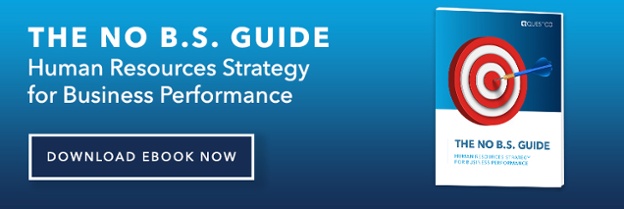Topic Outsourcing HR / PEO,
5 Ways to Give HR More Time to Focus on Revenue-Generating Activities

April 27, 2023 | By Questco Companies

In today’s competitive business landscape, the importance of Human Resources (HR) in driving revenue growth and organizational success cannot be overstated. A high-performing HR team is essential in attracting top talent, fostering employee engagement, and ensuring compliance, all contributing significantly to a company’s bottom line.
However, many HR professionals often find themselves burdened with administrative tasks, leaving them with limited time to focus on strategic, revenue-generating activities. To unlock the full potential of your HR team, it is crucial to create an environment that enables HR professionals to concentrate on high-impact initiatives.
Your role in facilitating HR’s revenue generation focus empowers the HR team to reach their goals. By implementing time-saving strategies and providing the necessary resources, employers can ensure that their HR professionals are well-equipped to significantly impact the company’s growth trajectory.
In this blog, we will explore how you can save your HR employees time, allowing them to focus on revenue-generating activities and ultimately propel the organization to new heights.
Understanding HR’s Revenue-Generating Potential
Before diving into the time-saving strategies that can empower HR to focus on high-impact activities, it’s essential to understand how HR can contribute to an organization’s revenue generation. By recognizing HR’s various roles in driving business growth, you can better prioritize the resources and support needed to help HR professionals succeed.
Some of the primary ways HR generates revenue include:
Talent Acquisition
Attracting and hiring top talent is crucial for any organization to thrive. A strong HR team will refine recruitment strategies, leverage technology, and optimize the candidate experience, securing high-quality talent that directly contributes to revenue growth.
Training and Development
Developing employees’ skills and improving their productivity through training programs is another way HR can impact revenue. By offering targeted training, organizations ensure their workforce remains competitive and agile, ultimately driving increased revenue.
Employee Engagement
Engaged employees are more productive, innovative, and committed to the organization’s success. HR teams are vital in creating programs and initiatives to boost engagement and job satisfaction, driving revenue growth.
With a clear understanding of how HR can contribute to revenue generation, you can focus on implementing strategies that free up HR professionals’ time and resources, enabling them to concentrate on these critical activities and support the organization’s growth objectives.
Next, we will explore some time-saving strategies you can adopt to help HR professionals maximize their impact on revenue generation.
5 Time-Saving Strategies for Employers
To empower HR professionals to focus on revenue-generating activities, employers need to implement time-saving strategies that streamline HR processes and create a supportive environment for HR teams to excel. Here are some practical steps employers can take to save time for their HR employees:
Streamline Administrative Tasks
By automating routine tasks such as payroll, time tracking, and applicant tracking, you can free up valuable time for HR staff to focus on strategic activities with a more significant impact on the company’s bottom line. Efficient HR software can be a game-changer in streamlining these administrative tasks, paving the way for HR teams to concentrate on revenue-driving initiatives.
Delegate Responsibilities
Empowering managers and team leaders to handle some of their department’s HR-related tasks can significantly alleviate the workload of HR professionals. Responsibilities such as conducting performance reviews and managing employee relations can be distributed across departments, allowing HR staff to devote more time to higher-impact tasks and initiatives.
Outsource Non-Core Activities
Partnering with specialized service providers to outsource certain HR functions, such as recruitment, background checks, or training, can be a highly effective strategy for freeing up HR personnel for more strategic tasks. This approach ensures that the organization continues to benefit from expert services while allowing HR professionals to focus on activities that drive revenue growth. If you choose a professional employer organization (PEO) as your HR outsourcing provider, you can see an average ROI of 27.2%.
Provide Additional Resources and Tools
Investing in tools, technology, and training can help HR staff work more efficiently and enable them to focus on revenue-generating activities. Implementing recruitment software, learning management systems, or workforce analytics tools can go a long way in helping HR professionals maximize their impact on the organization’s bottom line.
Encourage Cross-Functional Collaboration
Fostering collaboration between HR and other departments, such as marketing, sales, and finance, can help identify opportunities for revenue growth and support company-wide initiatives that drive business success. You can create a unified approach to achieving organizational goals by promoting cross-functional teamwork.
But how can you put these strategies into action?

Implementing Time-Saving Strategies
Now that we have identified the time-saving strategies that can help HR professionals focus on revenue-generating activities, we must discuss the steps in how to implement them.
Assess the Current State of HR Operations
First, evaluate the current HR processes, practices, and overall effectiveness. This assessment will help you identify areas where improvements can be made and determine the best course of action to empower your HR teams. By clearly understanding the existing HR landscape, you can create a targeted plan to enhance efficiency and impact.
Identify Areas for Improvement
Based on the assessment, employers should identify areas where they can streamline processes, delegate responsibilities, or provide additional resources. By pinpointing these opportunities for improvement, employers can develop a roadmap to transform their HR operations.
Collaborate with HR to Develop an Action Plan
You must collaborate with your HR team to develop an action plan to implement the identified strategies successfully. This collaboration will help secure HR’s commitment to the process and guarantee they have the necessary support and resources to succeed. Involving HR professionals in the planning stage is crucial for fostering ownership and accountability.
Monitor Progress and Adjust as Needed
Regularly monitoring progress is at the core of continuous improvement. Employers should track their HR teams’ performance and evaluate the implemented strategies’ effectiveness. By staying vigilant and adjusting as needed, employers can ensure that their HR teams remain focused on revenue-generating activities and contribute to the organization’s growth objectives.
By systematically implementing time-saving strategies, employers can successfully empower their HR teams to focus on high-impact, revenue-driving activities. This, in turn, will create a more effective and competitive organization, well-positioned to achieve its growth goals and maintain its competitive edge in the market.
However, before you can monitor progress, you’ll need a way to measure it.
How to Measure the Impact of Time-Saving Strategies
You’ll need to establish performance metrics and goals gauge your impact on HR’s ability to contribute to revenue growth. Continuous evaluation and refinement of the approach are crucial to optimizing the effectiveness of these strategies.
Set Performance Metrics and Goals
Establishing clear metrics and goals that align with the organization’s revenue-generating objectives is essential for measuring the impact of the time-saving strategies. These performance indicators may include metrics related to talent acquisition, employee engagement, training effectiveness, and overall HR efficiency. By setting expectations and benchmarks, employers can track HR’s progress and ensure that their initiatives are strategically focused and contribute to the company’s growth.
Evaluate the Effectiveness of Implemented Strategies
Regularly assessing the effectiveness of the implemented time-saving strategies is crucial for continuous improvement. Employers should monitor HR’s performance against the established metrics and goals, gathering feedback from HR professionals and other stakeholders to identify areas for further optimization. This ongoing evaluation process will help ensure that the time-saving strategies produce the desired results and that HR teams consistently focus on revenue-generating activities.
Continuously Reassess and Refine the Approach
In addition to evaluating the effectiveness of the implemented strategies, you should be prepared to make adjustments and refinements as needed. Continuously reassessing the approach will enable you to adapt to changing circumstances and ensure your HR team remains agile and growth-focused.
Conclusion
By implementing the time-saving strategies outlined in this blog and continuously evaluating their effectiveness, you can create a more efficient and high-performing HR team that significantly impacts the organization’s bottom line. One of the most cost-effective ways to save HR time and resources is partnering with a professional employer organization (PEO).
Partnering with a PEO provides comprehensive HR outsourcing services while offering complimentary state-of-the-art HR software to streamline administrative tasks and improve overall efficiency.
PEOs handle many non-core activities that consume valuable time and resources, allowing your HR team to focus on activities that drive revenue growth.
In summary, you are pivotal in enabling your HR team to succeed. By adopting the outlined strategies, considering a partnership with a PEO, and providing your HR team with the latest HR software, you can create a more effective and competitive organization that is better to thrive in today’s fast-paced business landscape.




